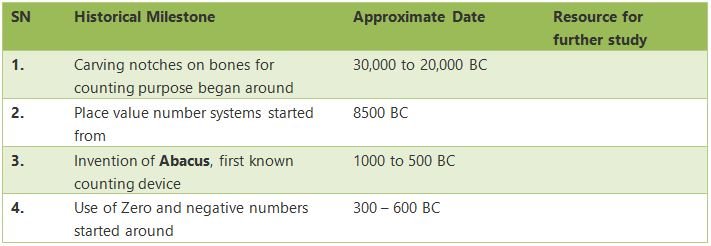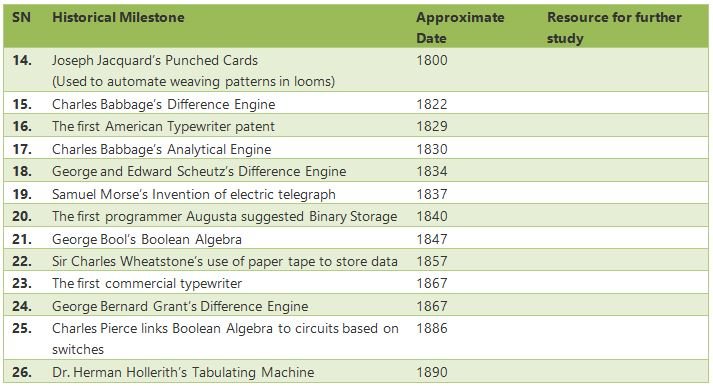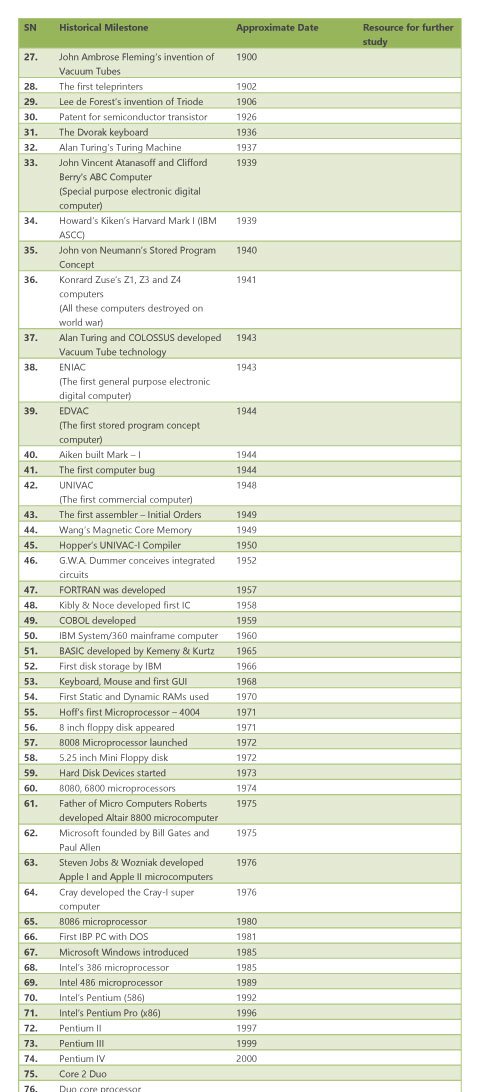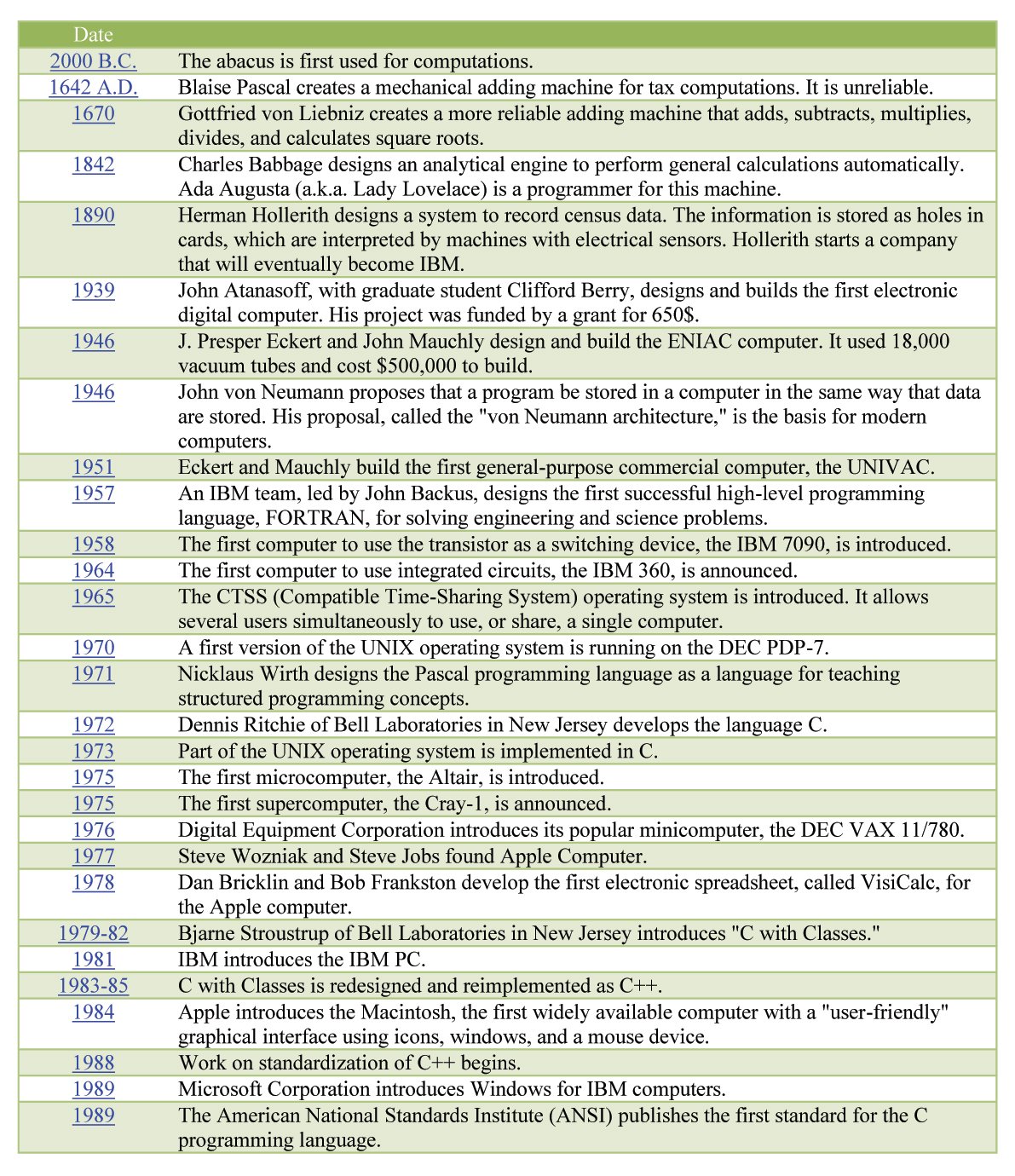The Historical Milestones in The Development of Computers
Computers emerged as the most powerful and useful devices, that shape up the modern world, out of the gradual improvement and innovation of calculating devices and mathematics. Here, in this post, we present the major computer milestones.
Computer Milestones – Early Ages
Distant Past Milestones
17th Century
18th Century in Computer Milestones
19th Century Computer Milestones
20th Century Milestones
Some Major Innovations in History of Computers
Presentation on Milestones in Computing
Source: http://www.cs.uno.edu/
Text used in presentation:
2000 B.C.: Abacus first used in computation
2000 B.C.: Abacus first used in computation
2000 B.C.: Abacus first used in computation
1642 A.D.: Blaise Pascal (French) creates a mechanical adding machine—the “Pascalene”—for tax computations
1671 A.D.: Gottfried von Leibniz (German) creates a more reliable adding machine that adds, subtracts, multiplies, divides, and calculates square roots—the “Staffelwalze”
1842 A.D.: Charles Babbage designs analytical engine to perform calculations automatically; Ada, countess of Lovelace, programs this machine
1890 A.D.: Herman Hollerith designs census recording system that uses punched cards; starts a company that later becomes IBM
1939 A.D.: John Atanasoff designs and builds first electronic digital computer (w/ graduate student Clifford Berry); called the ABC
1946 A.D.: J. Presper Eckert and John Mauchly design and build the ENIAC; considered the first modern computer, used vacuum tubes
1946 A.D.: John von Neumann proposes stored program architecture that bears his name
1951 A.D.: Eckert & Mauchly build the first general-purpose computer, the UNIVAC I
1957 A.D.: John Backus and his IBM team complete the first compiler (Fortran)
1958: IBM introduces the 7090 series, first to use transistors
1964 A.D.: IBM announces the 360, first to use integrated circuitry (IC)
1972 A.D.: Dennis Ritchie at Bell Labs develops the C Programming Language; precursor of Java
1975 A.D.: The Altair, the first microcomputer, is introduced
1976 A.D.: DEC introduces its popular minicomputer, the VAX 11/780
1977 A.D.: Steve Wozniak and Steve Jobs release the Apple I on April Fool’s Day, and found Apple Computers
1981 A.D.: IBM introduces its own PC
1985 A.D.: Bjarne Stroustrup at Bell Labs develops the C++ Programming Language; the Object-Oriented extension of C; precursor of Java
1991 A.D.: The internet is commercialized
1995 A.D.: Sun releases Java 1.0; object-oriented programming takes off
Download Milestones in Computer History as PPT file
Like, Tweet or +1 to display download link:
[l2g] Computer Milestones Presentation (ppt) [/l2g]
Yearly Index of Computer Milestones
Source: http://cba.winthrop.edu/
1937
Dr. John V. Atanasoff and Clifford Berry designed and build the first electronic digital computer. Their machine, the Alanasoff-Berry-Computer, or ABC, provides the foundation for advances in electronic digital computers.
1943
During World War II, British scientist Alan Turing designed the Colossus, an electronic computer for the military to break German codes. The computer’s existence is kept secret until the 1970s.
1945
Dr. John von Neumann writes a brilliant paper describing the stored program concept. His breakthrough idea, where memory holds both data and stored programs, lays the foundation for all digital computers that have since been built.
1946
Dr. John W. Mauchly and J. Presper Eckert, Jr. complete work on the first large-scale electronic, general-purpose digital computer. The ENIAC (Electronic Numerical Integrator And Computer) weighs thirty tons, contains 18,000 vacuum tubes, occupies a thirty-by-fifty-foot space, and consumes 160 kilowatts of power. The first time it is turned on, lights dim in an entire section of Philadelphia.
1947
William Shockley, John Bardeen, and Walter Brattain invent the transfer resistance device, eventually called the transistor. The transistor would revolutionize computers, proving much more reliable then vacuum tubes.
1951
The first commercially available electronic digital computer, the UNIVAC I (UNIVersal Automatic Computer), is introduced by Remington Rand. Public awareness of computers increases when the UNIVAC I, after analyzing only 5 percent of the popular vote, correctly predicts presidential election.
1952
Dr. Grace Hopper considers the concept of reusable software in her paper, “The Education of a Computer.” The paper describes how to program a computer with symbolic notation instead of the detailed machine language that has been used.
1953
The IBM model 650 is one of the first widely used computer systems. Originally planning to produce only 50 machines, the system is so successful that eventually IBM manufactures more then 1,000. With the IBM 700 series of machine, the company will dominate the mainframe market for the next decade.
Core memory, developed in the early 1950’s, (by An Wang ?) provides much larger storage capacity then vacuum tube memory.
1957
The IBM 305 RAMAC system is the first to use magnetic disk for external storage. The system provides storage capacity similar to magnetic tape that previously was used, but offers the advantage of semi-random access capability.
FORTRAN (FORmula TRANslation), an efficient, easy-to-use programming language, is introduced by John Backus.
1958
Computers built with transistors mark the beginning of the second generation of computer hardware.
1959
More than 200 programming languages have been created.
IBM introduces two smaller, desk-sized computers: the IBM 1602 initially is called the CADET, but IBM drops the name when campus wags claim it is an acronym for, Can’t Add, Doesn’t Even Try.
1960
COBOL, a high level business application language, is developed by a committee headed by Dr. Grace Hopper. COBOL uses English-like phrases and runs on most business computers, making it one of the more widely used programming languages.
1964
The number of computers has grown 18,000.
Third-generation computers, with their controlling circuitry stored on chips, are introduced. The IBM System/360 computer is the first family of compatible machines, merging science and business lines.
1965
Dr. John Kemeny of Dartmouth leads the development of the BASIC programming language. BASIC will be widely used on personal computers.
Digital Equipment Corporation (DEC) introduces the first mini-computer, the PDP-8. The machine is used extensively as an interface for time-sharing systems.
1968
In a letter to the editor titled, “ GO TO Statements Considered Harmful,” Dr. Edsger Dijsktra introduces the concept of structured programming, developing standards for constructing computer programs.
Computer Science Corporation becomes the first software company listed on the New York Stock Exchange.
1969
Under pressure from the industry, IBM announces that some of its software will be priced separately from the computer hardware. This unbundling allows software firms to emerge in the industry.
The ARPANET network, a predecessor of the Internet, is established.
1970
Fourth-generation computers, built with chips that use LSI (large-scale integration) arrive. While that chips used in 1965 contained as many as 1,000 circuits, the LSI chip contains as many as 15,000.
1971
Dr. Ted Hoff of Intel Corporation develops a microprocessor, or microprogrammable computer chip, the Intel 4004.
1975
MITS, Inc. advertises one of the first microcomputers, the Altair. Named for the destination in an episode of Star Trek, the Altair is sold in kits for less than $400. Although initially it has no keyboard, no monitor, no permanent memory, and not software, 4,000 orders are taken within the first three months.
Ethernet, the first local area network (LAN), is developed at Xerox PARC (Palo Alto Research Center) by Robert Metcalk. The LAN allows computers to communicate and share software, data, and peripherals. Initially designed to link minicomputers, Ethernet will be extended to personal computers.
1976
Steve Wozniak and Steve Jobs build the first Apple computer. A subsequent version, the Apple II, is an immediate success. Adopted by elementary schools, high schools, and colleges, for many students the Apple II is their first contact with the world of computers.
1979
VisiCalc, a spreadsheet program written by Bob Frankston and Dan Bricklin, is introduced. Originally written to run on Apple II computers, VisiCalc will be seen as the most important reason for the acceptance of personal computers in the business world.
The first public online information services, CompuServe and the Source, are founded.
1980
Alan Shugart presents the Winchester hard drive, revolutionizing storage for personal computers.
IBM offers Microsoft Corporation co-founder, Bill Gates, the opportunity to develop the operating system for the soon-to-be announces IBM personal computer. With the development of MS-DOS, Microsoft achieves tremendous growth and success.
1981
The IBM PC is introduced, signaling IBM’s entrance into the personal computer marketplace. The IBM PC quickly garners the largest share of the personal computer of choice in business.
1982
3,275,000 personal computers are sold, almost 3,000,000 more than in 1981.
Hayes introduces the 300 bps smart modern. The modem is an immediate success.
Compaq, Inc. is founded to develop and market IBM-compatible PCs.
1983
Lotus Development Corporation is founded. Its spreadsheet software, Lotus 1-2-3, which combines spreadsheets, graphics, and database programs in one package, becomes the best-selling program for IBM personal computers.
Instead of choosing a person for its annual award, TIME magazine names the computer Machine of the Year for 1982, acknowledging the impact of computers on society.
1984
IBM introduces a personal computer, called the PC AT, that uses the Intel 80286 microprocessor.
Hewlett-Packard announces the first LaserJet printer for the personal computers.
Apple introduces the Macintosh computer, which incorporates a unique, easy-to-learn, graphical user interface.
1987
Several personal computers utilizing the powerful Intel 803386 microprocessor are introduced. These machines perform processing that once only large systems could handle.
1988
Microsoft surpasses Lotus Development Corporation to become the world’s top software vender.
1989
While working at CERN, Switzerland, Tim Berners-Lee invents an Internet based hypermedia enterprise for information sharing. Berners-Lee will call this innovation the World Wide Web.
The Intel 486 becomes the world’s first 1,000,000 transistor microprocessor. It crams 1.2 million transistors on a .4”x .6” sliver of silicon and executes 15,000,000 instructions per second – four times as fast as its predecessor, the 803386 chip.
1991
World Wide Web Consortium releases standards that describe a framework for linking documents on different computers.
1992
Microsoft releases Windows 3.1, the latest version of its Windows operating system. Windows 3.1 offers improvements such as TrueType fonts, multimedia capability, and object linking and embedding (OLE). In two months, 3,000,000 copies of Windows 3.1 are sold.
1993
Several companies introduce computer systems using the Pentiumâ microprocessor from Intel. The Pentiumâ chip is the successor to the Intel 486 processor. It contains 3.1 million transistors and is capable of performing 112,000,000 instructions per second.
The White house launches its Web page. The site includes an interactive citizens’ handbook and White House history and tours.
Marc Andreessen creates a graphical Web browser called Mosaic. This success leads to the organizations of Netscape Communications Corporation.
1994
Jim Clark and Marc Andreessen found Netscape and launch Netscape Navigator 1.0, a browser for the World Wide Web.
Linus Torvalds creates the Linux kernal, a UNIX like operating system that he releases free across the Internet for further enhancement by other programmers.
1995
Microsoft releases Windows 95, a major upgrade to its Windows operating system. Windows 95 consists of more than 10,000,000 lines of computer instructions developed by 300 person-years of effort. More than 50,000 individuals and companies test the software before it is released.
Sun Microsystems launches Java, an object-oriented programming language that allows users to write one application for a variety of computer platforms. Java becomes one of the hottest Internet technologies.
1996
U.S. Robotics introduces PlamPilot a handheld personal organizer. The PalmPilot’s user friendliness and low price make it a standout next to more expensive personal digital assistants (PDAs).
Two out of three employees in the Untied States have access to a PC, and one out of every three homes has a PC. Fifty million personal; computers are sold worldwide and more than 250,000,000 are in use.
The Summer Olympics makes extensive use of computer technology, using an IBM network of 7,000 personal computers, 2,000 pagers and wireless devices, and 90 industrial-strength computers to share information with more then 150,000 athletes, coaches, journalists, and Olympics staff members, and millions of Web users.
Microsoft releases Windows NT 4.0, an operating system for client-server networks. Windows NT’s management tools and Wizards make it easier for developers to build and deploy business applications.
An innovative technology called webtv combines television and the Internet by providing viewers with tools to navigate the Web.
1997
Intel introduces the Pentiumâ II processor with 7.5 million transistors. The new processor, which incorporates MMXä technology, processes video, audio, and graphics data more efficiently and supports applications such as movie-editing, gaming, and more.
Microsoft releases Internet Explorer 4.0 and seizes a key place in the Internet arena. This new Web browser is greeted with tremendous customer demand.
DVD (Digital Video Disc), the next generation of optical disc storage technology, is introduced. DVD can store computer, audio, and video data in a single format, with the capability of producing near-studio quality. By year’s end, 500,000 DVD players are shipped worldwide.
Apple and Microsoft sign a joint technology development agreement. Microsoft buys $150,000,000 of Apple stock.
Deep Blue, and IBM supercomputer, defeats world chess champion Gary Kasparov in six games chess competition. Millions of people follow the 9-day long rematch on IBM’s Web site.
Fifty million users are connected to the Internet and World Wide Web.
1998
Microsoft ships Windows 98, an upgrade to Windows 95. Windows 98 offers improved Internet access, better system performance, and support for a new generation of hardware and software. In six months, more than 10,000,000 copies of Windows 98 are sold worldwide.
Google founded.
E-commerce, or electronic commerce- the marketing of goods and services over the Internet – booms. Companies such as Dell, E*TRADE, and Amazon.com spur online shopping, allowing buyers to obtain everything from hardware and software to financial and travel services, insurance, automobiles, books, and more,
More than 10,00,000 people take up telecommuting – the capability of working at home and communicating with an office via computer. More and more firms embrace telecommuting to help increase productivity, reduce absenteeism, and provide greater job satisfaction.
Apple Computer introduces the iMac, the latest version of its popular Macintosh computer. The iMac abandons such conventional features as a floppy disk drive but wins customers with its futuristic design, see-through case, and easy setup. Consumer demand outstrips Apple’s production capabilities, and some vendors are forced to begin waiting lists.
Compaq Computer, the United States’ leading personal computer manufacturer, buys Digital Equipment Corporation in the biggest takeover in the history. Compaq becomes the world’s second largest computer firm, behind IBM.
The Department of Justice’s broad antitrust lawsuit asks that Microsoft offer Windows 98 without the Internet Explorer browser or that it bundle the competing Netscape Navigator in browser with the operating system.
1999
Intel releases its Pentiumâ III processor, which provides enhanced multimedia capabilities.
U.S. District Judge Thomas Penfield Jackson rules in the antitrust lawsuit brought by the Department of Justice and 19 states that Microsoft used its monopoly power to stifle competition.
Microsoft introduces Office 2000, its premier productivity suite, offering new tools for users to create content and save it directly to a Web site without any file conversion or special steps.
Open Source Code software such as the Linux operating system and the Apache Web server created by unpaid volunteers, begin to gain wide acceptance among computer users.
Governments and businesses frantically work to make their computer systems Y2K (Year 2000) compliant, spending more than $500 billion worldwide. Y2K non-compliant computers cannot distinguish if 01/01/00 refers to 1900 or 2000, and thus may operate using a wrong date. This Y2K bug can affect any application that relies on computer chips, such as ATMs, airplanes, energy companies, and the telephone system.
2000
Internet provides offer computers free to those who sign up for their service, while hardware manufacturers offer application software free their computers.
Microsoft ships Windows 2000. Windows 2000 offers improved behind-the-scene security and reliability over its predecessor Windows NT. Its new Active Directory stores information about network devices and users and makes this information available to administrators, users, and applications.
According to the U.S. Commerce Department, Internet traffic is doubling every 100 days, resulting in an annual growth rate of more than 700 percent. It has taken radio and television 30 years and 15 years to reach 60 million people, respectively. The Internet has achiever the same audience base in 3 years.
Wireless technology achieves significant market penetration. Prices drop, usage increases, and wireless carries scramble for new services, particularly for a mobile workforce.
e-commerce achieves mainstream acceptance. Annual e-commerce sales exceed $100 billion and Internet advertising expenditures reach more than $5 billion.
Application service providers offer a return to a centralized computing environment, in which large megaservers warehouse your data, information, and software, so it is accessible using a variety of devices from any location.
2001
Microsoft introduces Office XP.
2002
Microsoft launches .NET strategy, which is a new environment for developing and running software application featuring ease of development of Web-based services.
2003
Microsoft ships Office 2003.
RIAA (Recording Industry Association fo America files over 250 lawsuits against individual computer users who offer copyrighted music over peer-to-per networks.
2004
Apple introduces iMac G5. Its display device contains the system unit.
2005
2006
Google has 54% of the search engine market over Yahoo! and MSN, and approx. 1 billion search requests per day.
Intel introduces the Core 2 Duo processor family. The processor contains 291 million transistors but uses 40 percent less power that the Pentium processor.
Microsoft unveils the Zune to compete against the Apple iPod.
IBM produces the fastest supercomputer called Blue Gene/L. It can perform approx 28 trillion calculations in about one-tenth of a second. It is used primarily to explore hydrodynamics, quantum chemistry, molecular dynamics, climate modeling, and financial modeling.
Apple begins selling Macintosh computer with the Intel micro-processors.
Microsoft releases Internet Explorer 7 (IE 7).
Mozilla releases Firefox 2
2007
Microsoft ships Windows Vista, and releases the Office 2007 suite of applications.
Other significant people and events
Donald E. Knuth published in 1968 (at age 30)Volume I of his monumental treatise “The Art of Computer Programming”.
Richard Stillman For pioneering work in the development of the extensible editor EMACS (Editing Macros)
Bjarne Stroustrop early work laying the foundations for the C++ programming language. Based on the foundations and Dr. Stroustrup’s continuing efforts, C++ has become one of the most influential programming languages in the history of computing
Milestones in Computer Input Devices
| 1950 | Light Gun: Robert Everett, Lincoln Lab, Lexington, MA. | |
| 1952 | Trackball: Tom Cranston and Fred Longstaff, Ferranti Canada. | |
| 1957 | Lightpen: Ben Gurley, Lincoln Lab, Lexinton, MA. | |
| 1960 | Glove-Based Keyboard: Robert Seibel & Nathaniel Rochester, IBM, NY. | |
| 1963 | Graphics tablet with stylus: The Rand Corp. | |
| 1964 | 3 DOF Trackball Controller: Lincoln Lab, Lexington, MA. | |
| 1964 | Mouse. Doug Engelbart and William English, Stanford Research Institute (SRI), Palo Alto, CA. | |
| 1965 | Touch Screen Technology Described: E.A. Johnson of the Royal Radar Establishment, Malvern, UK. | |
| 1966 | Three-Dimensional Wand: Larry Roberts, Lincoln Lab, Lexinton, MA. | |
| 1968 | First Ball Mouse: “RKS Rollkugel Steuerung ,” Rainer Mallebrein, Telefunken, Germany First Mouse to Ship Commercially First Commercial Computer to Ship with a Mouse: Telefunken TR86 |
|
| 1972 | Touch Screen, F.A. Ebling, R.L.Johnson & R.S.Goldhor, University of Illinois, Urbana Champlain. | |
| 1973 | Ball Mouse Redux: Ron Rider, Xerox PARC. | |
| 1981 | Optical Mouse. Independently developed by Steven Kirsch, Mouse Systems and Richard A. Lyon. | |
| 1982 | Glove and Body Joint Sensor: Thomas Zimmerman, VPL Research, Palo Alto. | |
| 1982 | Multi-Touch Input: Nimish Mehta, University of Toronto. | |
| 1983 | Rich Gesture Recognition, Myron Krueger. | |
| 1983 | PC with Touch Screen, Hewlitt Packard HP 150. | |
| 1984 | Multi-Touch Touch Screen: Bob Boie, Bell Labs, Murray Hill, N.J. The first transparent multi-touch screen overlay. |
|
| 1984 | Cordless Keyboard: PCjr “Freeboard” Keyboard, IBM. | |
| 1984 | Tablet with Cordless Sylus: Wacom, Japan. | |
| 1984 | Cordless Mouse: Metaphor Computer. | |
| 1985 | Scrolling Mouse: “Mighty Mouse”. NTT, Japan & ETH, Switzerland. | |
| 1986 | Apple Desktop Bus (ADB): Apple Computer. | |
| 1989 | Scroll-Wheel Mouse: D. Venolia, Apple Computer. | |
| 1991 | Cordless Mouse with RF Communication: MouseMan Cordless, Logitech | |
| 1995 | Commercial Scrolling Mouse: Genius EasyScroll / Mouse Systems ProAgio, Kye Systems Corp. | |
| 1997 | 2D Scrolling Mouse: TrackPoint Mouse, IBM Corp. | |
| 1999 | Optical Mouse Without Mouse Pad: Intellimouse, Microsoft Corp. | |
| 2011 | Bi-Directional Pixels in Interactive Display: Microsoft PixelSense, Microsoft Corp. & Samsung Electronics. | |






























Ray Holt says
World’s First Microprocessor
1968-70
See FirstMicroprocessor [dot] com
Ray Holt